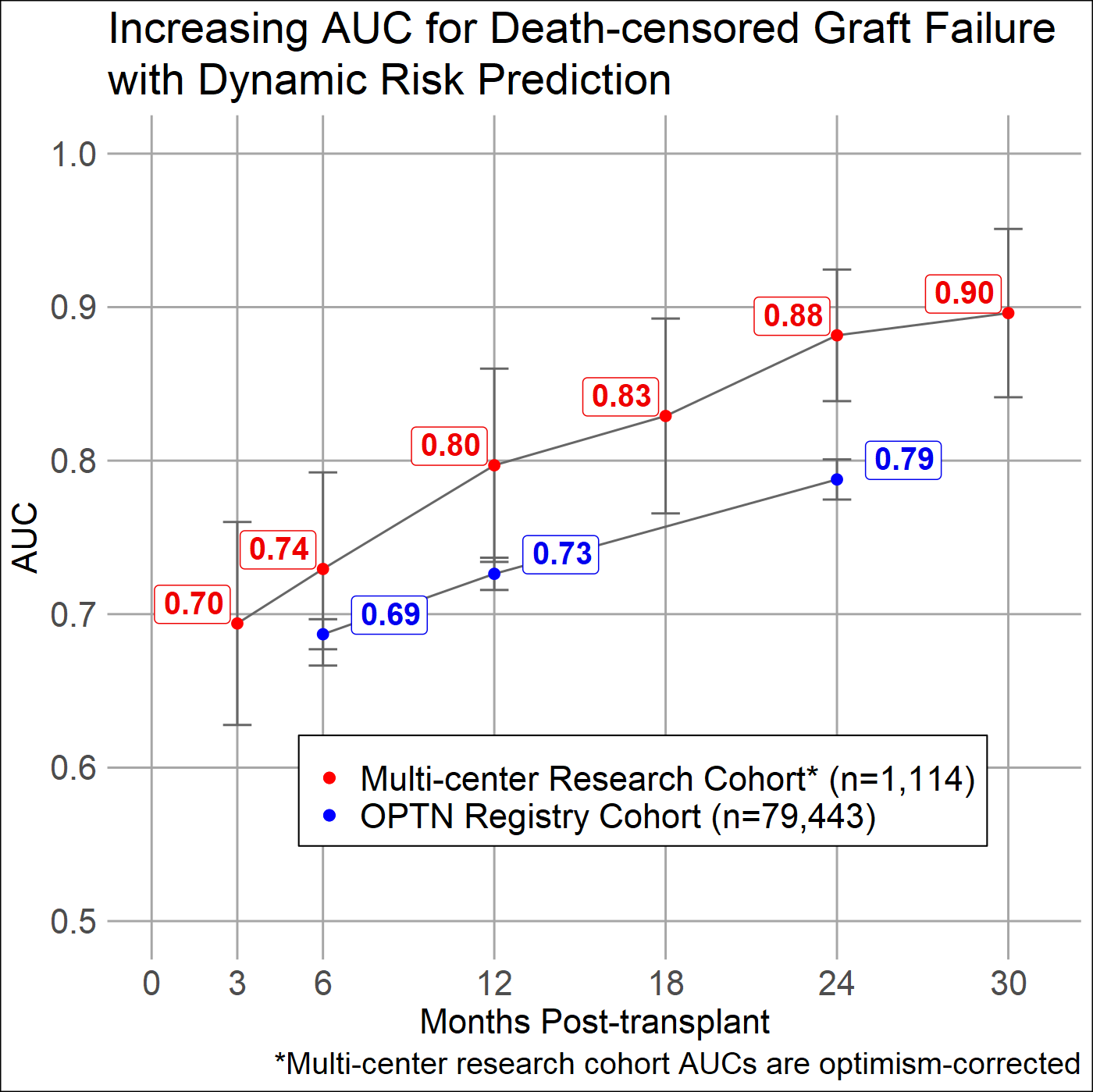Dynamic Risk Prediction of Kidney Graft Failure After Deceased Donor Transplant
1Johns Hopkins University, Baltimore, MD, 2Columbia University Medical Center, New York, NY, 3University of Utah, Salt Lake City, UT, 4University of Michigan, Ann Arbor, MI, 5University of Washington, Seattle, WA
Meeting: 2022 American Transplant Congress
Abstract number: 300
Keywords: Area-under-curve (AUC), Glomerular filtration rate (GFR), Prediction models
Topic: Clinical Science » Kidney » 46 - Kidney Complications: Non-Immune Mediated Late Graft Failure
Session Information
Session Name: Kidney Complications: Non-Immune Mediated Late Graft Failure
Session Type: Rapid Fire Oral Abstract
Date: Monday, June 6, 2022
Session Time: 5:30pm-7:00pm
 Presentation Time: 6:00pm-6:10pm
Presentation Time: 6:00pm-6:10pm
Location: Hynes Room 310
*Purpose: Identifying kidney transplant recipients at risk of graft failure allows for early intervention in clinical care. We developed a dynamic risk prediction model based on repeated estimated glomerular filtration rate (eGFR) measurements to predict 3-year death-censored graft failure (dcGF).
*Methods: In a prospective multi-center cohort of deceased donor kidney recipients transplanted from 2010 to 2013, we ascertained eGFR at 3, 6, 12, 18, 24, and 30 months. The primary outcome was dcGF within 36 months. We fit a two-stage model, first a mixed model summarizing eGFR trends, then a logistic model using estimates from the first stage as predictors. No additional variables were included in the model. We evaluated the optimism-corrected area under the receiver operating characteristic curve (AUC) to predict dcGF using any available post discharge eGFR measurements at several time points post-transplant. We also applied the model to Organ Procurement and Transplant Network (OPTN) registry data using 2010-2017 transplant recipients. eGFR values before 36 months in the OPTN registry were only available at 6, 12, and 24 months post-transplantation.
*Results: In the multi-center cohort of 1,114 recipients, 94 (8.4%) experienced dcGF between 3 and 36 months post-transplant and had a median of 12 (IQR 10 to 12) eGFR measurements. The predictive accuracy of the model improved over time from an optimism-corrected AUC of 0.70 at 3 months to 0.90 at 30 months post-discharge (Figure). Between 6 to 36 months, 4.9% of the 79,443 recipients in the OPTN registry experienced dcGF with a median of 3 (IQR 3 to 3) eGFR measurements. The AUC of dcGF ranged from 0.69 at 6 months to 0.79 at 24 months (Figure).
*Conclusions: The dynamic risk prediction model has moderate discrimination even with limited eGFR measurements. Repeated eGFR measurements appear to be a strong predictor of graft failure even in the absence of other information such as demographic or proteinuria data. The model performance was attenuated in the OPTN registry due to sparse renal function data post-transplant. Increased frequency of data collected in the OPTN registry may be considered to improve quality of care assessment and monitoring. Dynamic risk prediction has potential to be useful for monitoring the risk of graft failure in transplant recipients.
To cite this abstract in AMA style:
Hu DG, Philbrook HThiessen, Mohan S, Hall I, Doshi M, Kerr KF, Parikh CR. Dynamic Risk Prediction of Kidney Graft Failure After Deceased Donor Transplant [abstract]. Am J Transplant. 2022; 22 (suppl 3). https://atcmeetingabstracts.com/abstract/dynamic-risk-prediction-of-kidney-graft-failure-after-deceased-donor-transplant/. Accessed December 26, 2025.« Back to 2022 American Transplant Congress

